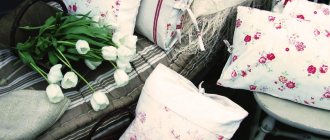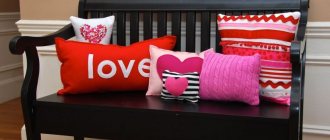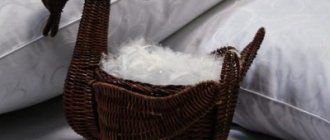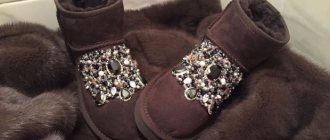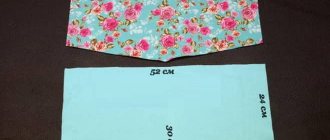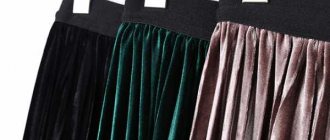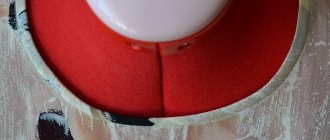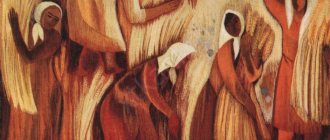Deciding on the sizes
Of course, you should start by determining the size of the pillow. To make a product “for yourself” as accurately as possible, use the following recommendations.
- The height of the pillow is a calculated value. Depends on the size parameters of the person for whom it is intended. Measure the distance from the ear (visually a vertical line lowered from it to the shoulder) to the edge of the shoulder. The resulting value will be the optimal height of the product.
- Analyze the moment in which position you prefer to spend most of the night. If your favorite position is sleeping on your back, the pillow should be slightly lower and denser. For those who prefer to sleep on their stomach, a soft, low pillow is suitable.
- Another factor to consider is the characteristics of the mattress. The harder and denser the mattress, the lower the pillow under your head should be.
Reference! Making a pillow with your own hands is an excellent opportunity to try it on and ultimately adjust the product to your parameters as much as possible. Do not immediately sew up the hole through which you insert the filler. Tack it with running stitches, test the pillow by adding or subtracting the amount of filling. Once the ideal result is achieved, the hole can be stitched.
Calculate fabric consumption
It is not difficult to calculate the fabric consumption for a pillowcase; to do this you need to know the size of the pillow. For example, let’s take two sizes: classic 70 x 70 and euro size 50 x 70. To sew a pillowcase for a pillow 70 x 70, its size should be 68 x 68 and for such a pillowcase we will need a piece of fabric 70 cm by 138 cm.
Now the pillow is 50 x 70, the pillowcase is 48 by 68 cm, the fabric needs 50 by 138 cm. Now let's look at the fabric itself, modern teak is produced in rolls 220 cm wide, so we need to arrange the cutting of the pillowcase so as not to buy too much, since the fabric not cheap.
It is most advantageous to arrange the napkin along the length of the fabric, that is, we buy a piece of fabric exactly 138 cm. From it we cut out three napkins, 70 cm x 3 = 210 cm, we have 10 cm of fabric left, it can be used if you have a summer house, for gartering tomato or raspberry bushes, that’s what I do.
I calculate the cost of hand-sewn bedsteads based on mixed teak, that is, with synthetics. A meter of such fabric costs an average of 300 rubles, multiplying by 1.38 gives 414 rubles. Divide by 3 and it turns out that one pillowcase for a 70 x 70 pillow costs 138 rubles.
For pillows 50 x 70, we cut the fabric for the pillowcase, depending on how many pillowcases we need, if there are four, then we take the same piece as in the previous case - 138 cm and measure 50 cm in width four times, the loss will be 20 cm. In this case, the napkin will cost us 103.5 rubles.
Deciding on the form
As for the shape, it all depends on your personal preferences. For the head option, a regular - classic - square or rectangular head is suitable. For travel - in the form of a bagel. For pregnant women - in the shape of a banana or the Latin letter U. Another newfangled option is a hugging (or body) pillow, which can be made in the shape of the letters G, I, C, P or G and be the size of a human being.
What materials to use
You should not be afraid of the task at hand. As practice shows, it is possible to sew a product without professional skills and in-depth knowledge of sewing. The main thing is to choose the right materials and scrupulously approach the task at hand.
For a confidant
Teak is still considered the most optimal fabric for making bedsteads. This option is especially relevant if you intend to fill the pillow with feather or down. If any of the artificial materials will be used as a filler, calico, ranfors, linen, poplin, satin, polysatin, jacquard, flannel, polycotton, knitted fabric, microfiber, percale, polyester, knitted velor can be used to sew the bedstead.
As a filler
Down, feather and wool, although they belong to a series of natural fillers, are still not the best option. These materials require regular cleaning, are excellent dust collectors and a favorable environment for the life of dangerous microorganisms that cause and aggravate allergic reactions. In addition, they quickly lose their shape.
In view of this, it is better to give preference to modern artificial materials. The following can be excellent hypoallergenic, springy fillers:
Hollofiber Practical, durable, springy material that is easy to care for. Siliconized fibers twisted into “springs” quickly restore their original shape after compression. Safe and hypoallergenic. Characterized by excellent thermal insulation and ventilation. Washable.
Holofiber filler.
Comforel Ball-shaped siliconized “granules”. Compared to holofiber, it is softer and less durable. Nevertheless, it holds its shape well, retains heat and is well ventilated. Does not accumulate odors. Washing is allowed.
Silicone “Sheet” holofiber. Hypoallergenic, well ventilated material. May have different degrees of density.
Synthetic fluff Soft, springy filler. Retains heat and is well ventilated. Easy to use, great material.
polystyrene Foamed polymer with a crumbly structure (in the form of miniature balls). An unusually lightweight material consisting of 98% air. A distinctive feature of products filled with expanded polystyrene granules is their neutrality to external temperatures (does not heat up from the body). Belongs to the category of semi-rigid fillers. The only inevitable drawback is a slight rustling sound from the friction of the granules against each other.
Reference! Synthetic winterizer is not recommended as a filler. Hypoallergenic and budget synthetic padding polyester is not elastic enough, holds its shape worse and quickly becomes loose.
Variants of the listed fillers, as a rule, are easy to purchase even in small cities (or on the Internet).
Unusual fillers
Buckwheat husks and cherry pits Natural fillers with a therapeutic effect. They do not harbor dust mites, which is important. The downsides include the rustling sound the pillows make and difficulty in cleaning. Products cannot be washed. Pillows with buckwheat husks and cherry pits are not intended for regular night sleep, as these fillers are not orthopedic enough.
Herbal pillows A hot topic for aromatherapy lovers. Before you start creating a grass pillow, you should familiarize yourself with some important nuances. For example, keep in mind that fragrance is a kind of medicine and should be selected carefully. Since the herbs themselves do not hold their shape well, sedge, fireweed fluff, heather or straw are used as a base. Herbs must be fresh and well dried. The service life of such pillows is 1-2 years, subject to storage rules.
Orthopedic fillers
Orthopedic pillow fillers include natural latex, polyurethane foam and viscoelastic foams (memory type). In principle, if you wish, you can even find such fillers (sheet versions) on sale. It is unlikely that it will be possible to depict an ergonomic wave-like or massage version (although for those who are especially persistent, nothing is impossible), but a rectangle or square is quite possible.
For pillowcase
The range of fabrics from which you can make a cover or pillowcase is huge - for every taste and budget.
Chintz
The most affordable option. Has an incredibly wide variety of colors. Hygroscopic material - perfectly breathable and absorbs moisture. At the same time, it is not durable enough, is not resistant to abrasion, and shrinks when washed (before cutting, it is better to soak a piece of fabric in water at the temperature in which you will subsequently wash the pillowcases).
Satin
A more expensive, practical, comfortable option. Beautiful and durable fabric.
Natural silk
Expensive, luxurious material with thermoregulating properties. Quite demanding in care.
Poplin
A noble fabric created from cotton and silk fibers. More durable and less fussy than 100% silk.
Linen
Linen for bed linen often implies the presence of cotton fibers (for softness). Very practical and durable material. The disadvantages include high creasing and difficulty in ironing.
Bamboo
Durable fabric with properties typical of viscose materials. It is not natural, although it is produced from individual parts of the bamboo plant.
Velor and terry
Modern, original, durable fabrics, warm and soft. They absorb moisture well and do not slip.
Tools
In addition to having the necessary materials, you will need the following tools:
- threads in the color of the fabrics
- measuring tape, ruler
- cutting scissors
- tailor's pins
- sewing machine
- zipper length 25 cm
- pattern paper and pencil
- sharpened soap or chalk
How to choose fabric
The selection of material does not end with its composition and weaving density; other characteristics are also important. This is the airiness of the fabric, the thickness of the canvas, the looseness of the product and how it feels to the touch. But it is desirable that it also complements the properties and purpose of the filler itself. If it must retain heat, be ventilated and be soft, since it is made from a wool mixture, then it is better to select material with similar qualities.
Products sold in stores are sewn using special technology on industrial sewing machines.
For a synthetic pillow (with microfiber)?
This option is not particularly demanding; it holds its shape on its own and does not jump out in all directions. Therefore, the cover can be sewn or purchased from the fabric that is most pleasant to the touch. Many people prefer satin or microfiber; cotton is also held in high esteem, including those mixed with other types of fibers.
Before buying fabric, you need to decide on the size of the pillow and their quantity.
For down pillow
Down has such properties that it has to be shaped and prevent small elements from falling out. That is, there must be a napkin material that has strength, weaving density and wear resistance. For this, teak may be the best option; it has all these qualities.
Thanks to a special production technology, unlike ordinary fabric, teak does not allow feathers to pass through.
For silk pillow
Silk pillow fabric is often diluted with synthetic additives. This is necessary to prevent the product from jumping out. After all, pure silk has average properties, except for the peculiarity of a slippery surface.
As for colors, it is preferable to choose a light or plain fabric.
For a pillow with wool
Wool fabric for a pillow tends to prick, but does not come out through the threads of the material. Therefore, you can use satin for this, it is soft and smoothes out the unpleasant sensations from wool. Although any option that is most comfortable for the owner will do.
Choose a fabric that will be pleasant to the skin, allow it to breathe and will help quickly remove moisture.
Carrying out work step by step
If you have stocked up on all the necessary materials and tools, you can start making the pillow. The algorithm for performing the work is as follows.
- Making a paper pattern. The dimensions and shape of the patterns depend on your preferences and the chosen model. Alternatively, you can take ready-made parameters from the Internet, or use someone else’s experience (pattern).
- Transferring the finished pattern onto the fabric. To avoid displacement, it is better to pin paper patterns to the fabric with tailor's pins. The pinned patterns are traced along the contour with a sharpened soap or cutting chalk.
- Reveal the details. The parts are cut out taking into account seam allowances (for stitching). The size of the allowance is 1-1.5 cm.
- Basting and stitching pillow parts. Pieces folded face to face are basted or pinned with tailor's pins (to avoid displacement during the stitching process). Sew down the parts, leaving the hole for inserting the filler free, and turn the napkin inside out onto your face.
- Filling. The pillow is slowly filled with filler, distributing it evenly. As mentioned above, the hole for inserting the filler should not be filled in immediately. It is better to “grab” it manually using running stitches (or sew in a zipper) and test the product for several days or nights. You may need to increase or decrease the amount of padding to achieve optimal comfort.
Calculate the fabric and sew the napkin in the most simple and hassle-free way
Anyone can sew a pillow cover, even if they have no sewing skills.
To do this, you need to calculate the fabric consumption, go to the store and choose teak, let’s assume that you have a sewing machine. It is necessary to change the pillowcase when, when changing pillowcases, you see an unsightly picture of yellow spots and stains on the pillowcase. This is also a signal that it’s time to clean the pillows. Where and how you can clean down feather products is described here.
https://www.youtube.com/watch?v=Y0-52TJ6C6c
In salons and dry cleaners there is a choice of sizes and colors, but you are not satisfied with something and want to clean your diapers. You have every right! Below we will discuss why you need to buy ready-made napkins in a store very carefully, otherwise disappointments will follow.
What kind of fabric is teak?
Let's not go far into the past, but back in the 20th century, teak was a 100% natural cotton fabric with a thread density of 140 - 160 grams per square meter. This kind of fabric was used to make mattress covers; remember those with stripes?
The fabric with a density of 140 was used for sewing napkins. This indicator ensures that the feather and down will not leave the pillow if you don’t want it to. 100% cotton was responsible for the hygroscopicity of the fabric and its breathability. That is, the feather in the pillow could become damp from your sweat and just as easily dry out on the stove or near the radiator.
Nowadays, teak is a fabric with a synthetic thread content of up to 50% or more, it has retained almost all its properties, you just sweat on it a little more, such fabric feels much thinner to the touch than its natural predecessor, and in order to preserve the main property of teak not to allow the contents of the product to pass through, they process it material with special impregnation.
It is this that causes the fabric to rustle during the first month of using a pillow or blanket. Some people are very annoyed by this and such people prefer to look for natural teak, although this is becoming more and more difficult from year to year, and this is where grandma’s supplies can help.
I can say that this drawback disappears over time, but the same impregnation makes the bedsteads disposable in use. What do I mean? The fact is that when washed, the impregnation disappears and the fabric begins to let through everything that is inside the pillow. This is especially true for feathers and down.
Hence the moral: if you don’t know for sure what your napkin is made of, then it’s better not to wash it, but to throw it away immediately. Irritation from feathers flying around the apartment will cover all expenses.
It is not difficult to calculate the fabric consumption for a pillowcase; to do this you need to know the size of the pillow. For example, let’s take two sizes: classic 70 x 70 and euro size 50 x 70. To sew a pillowcase for a pillow 70 x 70, its size should be 68 x 68 and for such a pillowcase we will need a piece of fabric 70 cm by 138 cm.
Now the pillow is 50 x 70, the pillowcase is 48 by 68 cm, the fabric needs 50 by 138 cm. Now let's look at the fabric itself, modern teak is produced in rolls 220 cm wide, so we need to arrange the cutting of the pillowcase so as not to buy too much, since the fabric not cheap.
It is most advantageous to arrange the napkin along the length of the fabric, that is, we buy a piece of fabric exactly 138 cm. From it we cut out three napkins, 70 cm x 3 = 210 cm, we have 10 cm of fabric left, it can be used if you have a summer house, for gartering tomato or raspberry bushes, that’s what I do.
I calculate the cost of hand-sewn bedsteads based on mixed teak, that is, with synthetics. A meter of such fabric costs an average of 300 rubles, multiplying by 1.38 gives 414 rubles. Divide by 3 and it turns out that one pillowcase for a 70 x 70 pillow costs 138 rubles.
For pillows 50 x 70, we cut the fabric for the pillowcase, depending on how many pillowcases we need, if there are four, then we take the same piece as in the previous case - 138 cm and measure 50 cm in width four times, the loss will be 20 cm. In this case, the napkin will cost us 103.5 rubles.
READ MORE: Feeding orchids during flowering, how to feed a blooming orchid at home and when it needs to be fed
Or you can buy exactly a meter of teak and measure the width 3 times by 70 cm, you will get three patterns and also a 10 cm strip of excess fabric. Here 300: 3 = 100 rubles.
Sew a breastplate
A little higher we talked about the fact that today napkins are a disposable thing. It can only be reused after washing as a bag for storing or carrying something.
Accordingly, you shouldn’t bother with the beauty of the seams, the main thing here is that it (the seam) does not let fluff through. To do this, we fold the cut piece of fabric with the wrong side inward, step back 20 cm from the fold, this is the hole for stuffing, and begin sewing three sides together on the machine.
The length of the seam stitch pitch should be 2 - 2.2 mm, this will hold the down and feathers inside the bib, we retreat from the edge of the fabric, placing 1 cm on the seam.
If you don’t trust anyone, then make two similar seams, stepping back a couple of millimeters from the first, and then your darling will be calm. After sewing even two seams, you will spend 5 minutes and the napkin is ready.
Neither you nor anyone else will see that the inside edges of the fabric are not processed in any way, again we remember that this is before the next cleaning of your pillow and the dirty pillowcase will go in the trash, and it is recommended to clean it once a year.
It may happen that when you come to the store to buy teak, you find a fabric 150 cm wide, then take a closer look and talk to a consultant, perhaps it is natural teak without synthetics. Unfortunately, it now does not have the same properties that it had before in terms of throughput, today they are worse, but the absence of rustling is an important argument for some.
Here's how to calculate the amount of fabric if its width is 150 cm. We remember how many napkins we need, then we calculate for one napkin per pillow 70 x 70 we need 70 cm of fabric, then measure the width 138 and cut off the remaining 12 cm. That's it. If you need two bedsteads, we buy 1.40 m accordingly.
For a pillow 50 x 70 for one pillowcase you will need 50 cm of fabric, then everything is the same as for a pillowcase 70 x 70.
Is it possible and necessary to buy napkins in the store? Here the decision is yours, there are arguments, both For and Against. For is something that you don’t have to think, count, choose, do for yourself. The downside is that they will rarely tell you exactly what fabric this product is made of; it may happen that at the price of 100% cotton they will sell you 100% synthetics. Yes, this is also possible with fabric, but less often.
Next, before purchasing, carefully examine the seams of the product; it is better to do this with glasses, otherwise you will have to make a second seam at home. Well, the color options in finished products are always smaller than in fabrics.
In custody
To sew a pillowcase yourself, I think you understand, it’s not difficult. There are also napkins with edging, that is, an edging (ribbon) is sewn into the seam around the perimeter, it can be satin, this is done to attract the client, it does not provide any functionality. Therefore, when we sew ourselves, we don’t use anything like this, as we save our time and money.
Life needs to be simplified and we can do this if we sew some of the necessary things ourselves. We've discussed how to sew a pillowcase yourself; there's a note that explains how to sew or alter pillowcases, and also how to sew a duvet cover with your own hands. This is almost a complete set of bed linen, and anyone can sew a sheet.
I tried to cover all the intricacies of this matter, if I forgot something, or did not explain it clearly, write in the comments.
READ MORE: Double doors, street entrance doors to a private house or cottage, beautiful models of all varieties
Sewing yourself today is more of an entertainment than a necessity, so this information is for those who want to learn something new and useful for themselves.
Repost and win a laptop!
Every 1st and 15th iBook.pro gives away gifts.
- Click on one of the social buttons. networks
- Get a personal coupon
- Win a LENOVO laptop >Details: ibook.pro/konkurs
LENOVO IdeaPad Intel Core i5, 8GB DDR4, SSD, GeForce, Windows 10
DIY travel pillow
If you travel often and for a long time, then you are familiar with the feeling of discomfort experienced every time you try to take a nap while sitting in a waiting room, in a car, bus, train or plane. Why not buy (or make your own) a travel pillow? It's actually very simple and won't take much time.
Travel pillows are usually shaped like a bagel or a horseshoe. It is this option that most comfortably supports the neck and head during “sedentary” sleep. To make such a pillow, use natural or mixed pleasant, non-slip fabric for the cover (usually fleece, flock, spandex, less often - polyester, nylon, cotton, linen, satin) and artificial filler (usually holofiber).
The principle of performing the work is similar to that described above.
- Making a paper pattern.
- Transfer the pattern to the fabric folded in half (face to face).
- Cut taking into account allowances.
- Sweeping or chipping parts.
- Sewing parts (don't forget to leave a hole for inserting filler!).
- Turn the product inside out and fill it evenly with filler.
- Sealing the hole.
Decorative pillows
All of the above principles apply equally to the production of decorative pillows.
Recommended fillers - holofiber, comforter, synthetic down, polystyrene foam granules, foam rubber (polyurethane foam), foam rubber crumbs.
The variations in sizes and shapes are limitless (you can come up with your own or choose any model you like from the Internet).
There are many more samples of materials for sewing pillowcases than for models for sleeping. Since the purpose of these pillows is to decorate the interior, the materials for pillowcases are not subject to very strict requirements in terms of naturalness and hygroscopicity. Any theme would be appropriate here - from furniture flocks and tapestries to natural and artificial fur, as well as patchwork and the use of accessories.

